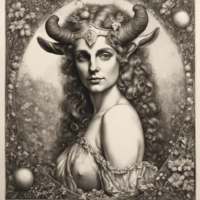Faun: Difference between revisions
No edit summary |
No edit summary |
||
| Line 1: | Line 1: | ||
{| border=0 align=right cellpadding=4 cellspacing=0 width=300 style="margin: 0 0 1em 1em; background: #f9f9f9; border: 1px #aaaaaa solid; border-collapse: collapse; font-size: 100%;" | {| border=0 align=right cellpadding=4 cellspacing=0 width=300 style="margin: 0 0 1em 1em; background: #f9f9f9; border: 1px #aaaaaa solid; border-collapse: collapse; font-size: 100%;" | ||
|+<big><big>''' | |+<big><big>'''Faun'''</big></big> | ||
| align="center" colspan="2" style="background:#FFFFFF;"| | | align="center" colspan="2" style="background:#FFFFFF;"| | ||
{| border=0 cellpadding=2 cellspacing=0 style="background:none; text-align:center;" | {| border=0 cellpadding=2 cellspacing=0 style="background:none; text-align:center;" | ||
Revision as of 23:34, 15 May 2024
Faun is the second of the major moons of the planet Thalassa.
Mythology

Faun, the revered Lady Divine of Natural Balance and Fertility, is believed to have emerged from the heart of the ancient forests, embodying the interplay of life and growth. Born amidst the verdant splendor of the wilderness, she personifies the balance of the natural world and the bountiful abundance of the earth.
Epithets
Faun is adorned with epithets that reflect her divine nature and influence. Among these titles are "Lady of the Grove," symbolizing her stewardship of the sacred forests, and "Mother of Renewal," representing her role in nurturing new life and growth. She is also known as the "Bearer of Blessings," signifying her ability to bestow fertility and abundance upon the land.
Worship and Festivals in Bassaridia Vaeringheim
In the bustling city of Sylvapolis, worshipers of Faun gather to honor their divine patron through rituals of fertility and renewal. One notable practice of the Sylvan Fellowship, carried out in honor of Faun at the Hollow Gate, is known as the Rite of Verdant Passage. At the Hollow Gate, a sacred site shrouded in myth and mystery, initiates of the Sylvan Fellowship embark on a transformative journey into the depths of the earth, guided by the primal energies of Faun. The Hollow Gate is believed to mark the beginning of the path which connects the mortal realm and the underworld, a realm known in Reformed Bassarid traditions as "the Emptiness." During the Rite of Verdant Passage, initiates gather at the entrance to the Hollow Gate. Under the canopy of ancient trees, the air is charged with the scent of earth and moss, and the murmuring of hidden streams adds to the sense of enchantment that permeates the sacred grove. As dusk falls and shadows lengthen, initiates prepare themselves for the journey ahead, invoking the blessings of Faun and the spirits of the earth. They adorn themselves with garlands of ivy and oak leaves, symbols of vitality and resilience, and imbibe potions brewed from rare herbs and intoxicating fruits, designed to heighten their senses and attune them to the primal energies of the earth. With torches in hand and hearts brimming with anticipation, the initiates pass through the Hollow Gate and ultimately into the depths of the earth. Guided by the flickering light of their torches and the rhythmic beat of drums, they descend into the labyrinthine tunnels and caverns that wind their way through the earth's core. As they journey deeper into the underworld, initiates encounter strange and wondrous sights: glowing fungi that illuminate the darkness, crystal-clear pools that shimmer with otherworldly light, and ancient petroglyphs that tell the stories of forgotten civilizations. Along the way, they face trials of courage and endurance, testing their mettle and forging bonds of camaraderie with their fellow travelers. At the culmination of their journey, initiates reach the heart of the underworld, a place of profound stillness and primordial power. Here, amidst the echoing chambers and towering stalactites, they commune with the spirit of Faun and receive her blessings of renewal and transformation. In this moment of communion, initiates experience a profound sense of connection to the natural world and a deep understanding of their place within it.
The Sylvan Fellowship
At the heart of Faun's worship lies the esteemed Sylvan Fellowship, a Reformed Bassarid cult of women, known as Sylvanists, dedicated to honoring the cycles of nature and embracing the primal energies of the earth. Nestled within the verdant surroundings of Sylvapolis, the Fellowship operates as a sisterhood of priestesses, healers, and artisans, devoted to cultivating harmony and balance within themselves and the world around them. Members of the Sylvan Fellowship engage in rituals of dance, music, and ecstatic revelry, channeling the untamed energies of the natural world and communing with the spirit of Faun. They celebrate the changing seasons with elaborate festivals and ceremonies, honoring the rhythms of growth and decay that shape the cycle of life.
Mythology
Ancient myths and legends surrounding Faun depict her as a figure of beauty and grace, her origins intertwined with the fertile soil and the whispering leaves of the forest. She is often portrayed as a radiant nymph, her laughter echoing through the woodland glades and her presence imbuing the natural world with vitality and vitality. Tales of Faun's influence on mortal affairs abound, with her blessings sought by farmers, gardeners, and all who depend on the bounty of the earth for sustenance.
Iconography and Depictions
In art and iconography, Faun is often depicted as a radiant nymph adorned with garlands of flowers and draped in flowing robes of green and gold. She is frequently portrayed amidst the verdant splendor of the forest, surrounded by woodland creatures and blooming flowers. Symbols associated with Faun include the horn of plenty, representing abundance and fertility, and the wreath of ivy, symbolizing the eternal cycle of life and growth. Faun is also closely associated with Morovian Sasquatch, who are regarded as her earliest followers and worshipers. Depictions of Faun capture her ethereal beauty and boundless vitality, inspiring worshipers to embrace the blessings of nature and cultivate a deeper connection with the Lady Divine of Natural Balance and Fertility.

